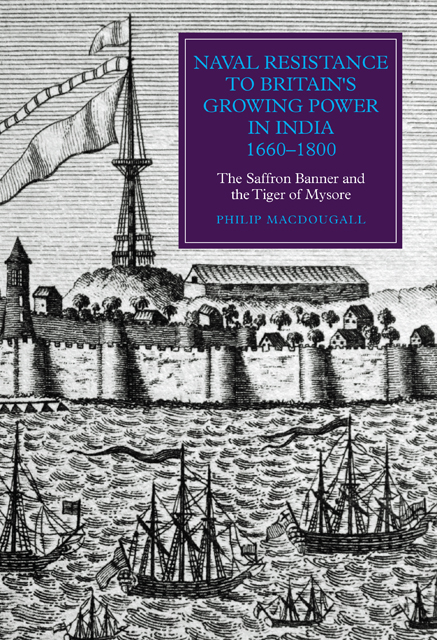 Naval Resistance to Britain's Growing Power in India, 1660–1800
Naval Resistance to Britain's Growing Power in India, 1660–1800 Book contents
- Frontmatter
- Contents
- List of Illustrations
- Abbreviations
- Chronology
- Maps
- Preface
- Part I Early Naval Resistance: The Historical Background
- Part II The Saffron Banner: Irregular Naval Warfare against an Emergent Britain
- Part III The Tiger of Mysore: A Conventional Navy to Oppose British Dominance
- Conclusion
- Bibliography
- Index
- Worlds of The East India Company
Introduction
Published online by Cambridge University Press: 23 February 2023
- Frontmatter
- Contents
- List of Illustrations
- Abbreviations
- Chronology
- Maps
- Preface
- Part I Early Naval Resistance: The Historical Background
- Part II The Saffron Banner: Irregular Naval Warfare against an Emergent Britain
- Part III The Tiger of Mysore: A Conventional Navy to Oppose British Dominance
- Conclusion
- Bibliography
- Index
- Worlds of The East India Company
Summary
A plain saffron-coloured swallowtail banner was the ensign flown by many of the fighting ships of the confederated Maratha Empire, although saffron-coloured sails were another feature of identification. The precise date of adoption is unclear, Fryer noting that in 1676 the flagship leading a thirty-strong fleet of Maratha warships flew a ‘white flag’ aloft. If nothing else, this suggests that the saffron flag, a colour sacred to Hindus and the Maratha polity, was not to regularly appear until a later date. Originally a warrior caste, the Marathas were primarily found in the Maharashtra, an area of land that had essentially fallen under the control of the Mughals at the beginning of the sixteenth century, with part also under the control of the Sultanate of Bijapur. In itself the empire was formerly established in 1674 when its founder, Shivaji Bhosale (c.1627–80), was crowned Chhatrapai (paramount sovereign). Shivaji himself was a devoted Hindu, as were, but by no means exclusively, many of his followers and those subject to his authority. Initially, Shivaji’s attempts at separating his people from the Mughals and the Sultanate for the purpose of welding them into a separate nation had seen considerable fighting within the Deccan Plateau before entering the Konkan coastal region, which brought him into contact with the European merchant trading companies together with the naval arm of both the Mughals and their allies the Siddis of Janjira.
That a Maratha fleet was created in the late seventeenth century was not, at that time, for the purpose of undermining the position of the European powers – not even that of the increasingly powerful EIC. Instead, it was designed to counter the Mughal and Siddi fleets that were being used to provision and support land forces then in conflict with the Marathas along the Konkan Coast. However, it was the rapid growth of the Maratha fleet at that time, and at a time when the EIC was still fundamentally weak, that the Marathas had their best chance of eradicating an English presence along the west coast of India. That they did not do so, and working very much to the advantage of the EIC, was due to the on-going war with the Mughals. Indeed,
- Type
- Chapter
- Information
- Naval Resistance to Britain's Growing Power in India, 1660–1800The Saffron Banner and the Tiger of Mysore, pp. 41 - 45Publisher: Boydell & BrewerPrint publication year: 2014


